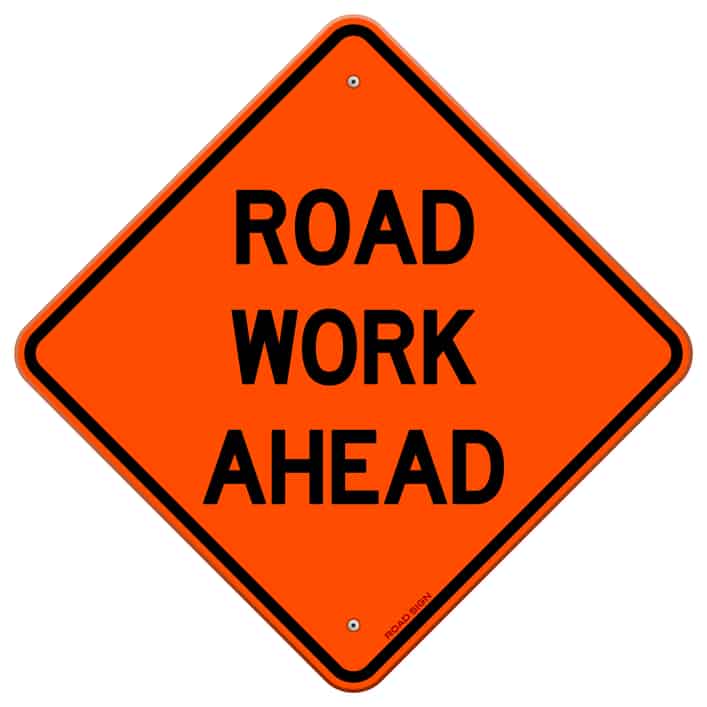What to Do When Driving by Road Work Zones
August 10, 2020
7 Essential Driving Tips for Safely Navigating Highway Work Zones
Over the past five years, 4,400 people have been killed—and 200,000 others have been injured—in road work zones accidents. That’s according to the latest findings, which also reveal that:
- The vast majority of highway work zone accidents occur during the summer and fall.
- About 85% of those killed in highway work zone accidents are vehicle occupants.
- Driver distraction plays a role in more than 11% of these deadly accidents.
- Most deadly wrecks in road work zones occur in areas with speed limits over 50 miles per hour (mph).
- More than 1 in every 4 highway work zone accidents involves a large truck.
- Rear-end collisions are the most common type of accident to occur in road work zones.
Given that highway work zones can disrupt typical driving conditions, it’s no wonder these areas are so often the sites of crashes. If you know how to drive through road work zones, however, you can reduce your risk and safely navigate these areas.
7 Tips for Driving Through Road Work Zones
Follow these tips to get through any road work zone as safely as possible.
1. Stay fully focused on the road & driving environment at all times.
Things can change fast in areas where road work is being done. From traffic conditions to moving equipment on or by the road, there can be a lot going on in the kinetic environment of highway work zones.
So, pay attention to your surroundings and what you’re doing. Don’t try to multitask while driving through road work zones (or whenever you’re driving, really). You could miss an essential cue and make a damaging or even potentially deadly mistake.
2. Look for signs.
Speed limits, lanes of through traffic, and/or routes are just some of the things that change when road work is being done. Signage will specify exact what changes to expect as you approach and move through the highway work zone. So, keep an eye out for those signs, and do what they tell you to do.
3. Keep your headlights on.
You’ll be easier for crew and others on the road to see if you have your headlights on. This includes during the day. It’s a simple way to stay as visible as possible.
4. Leave plenty of space between vehicles.
Knowing that rear-end collisions are the most common type of highway work zone accident, never tailgate in these areas. Also:
- Pay attention to the brake lights on the vehicles you’re following.
- Add at least 100 feet (ft) of additional space when the roads are wet.
- Quadruple the space between vehicles in icy conditions.
5. Listen to & obey any instructions from a flagger.
A flagger is the person directing traffic. If you see a sign indicating there’s a flagger ahead, be prepared to stop and follow the instructions provided.
Flaggers are trained to facilitate traffic safely while providing space for a road work crew to do their job. So, pay attention to their cues and do what they ask you to do.
6. Drive defensively.
Be prepared for crew, equipment, or vehicles to suddenly enter your lane of traffic. If you anticipate sudden changes in the driving environment, you’ll be prepared to respond to them, as needed, ASAP.
7. Stay calm & be patient.
Highway work zones can slow down and even bottleneck traffic. While that’s not ideal, it’s important to remember that work crew are working to fix, build, and/or improve roads. Getting upset or angry about congestion or changes in your commute won’t do you or anyone else any good.
What to Do After a Highway Work Zone Accident: 11 Steps to Take
As cautious as you may be behind the wheel, other drivers can be another story. You never know how sober, attentive, or safe other motorists may be.
In the event another driver—or any other party—causes an accident, here’s what you can do to protect yourself and your rights:
- Get out of the way of traffic ASAP.
- Call 911 or a nonemergency police number.
- Get emergency medical care, if needed.
- Exchange driving, insurance, and contact information with the other involved parties.
- Take pictures and videos of everything—the damage, visible injuries, the accident scene as a whole, the road conditions, the weather—everything you can.
- Never admit fault, accept blame, or apologize for the accident.
- Only discuss the facts of the crash that you’re sure of, regardless of whether you’re speaking with police at the scene or an insurance adjuster later.
- Keep everything you collect and receive related to the accident.
- Get the follow-up medical care you need, and don’t skip any necessary treatments or care.
- Report the accident to your auto insurance provider as soon as reasonably possible.
- Contact an attorney to get answers about your rights and legal options for financial recovery.
